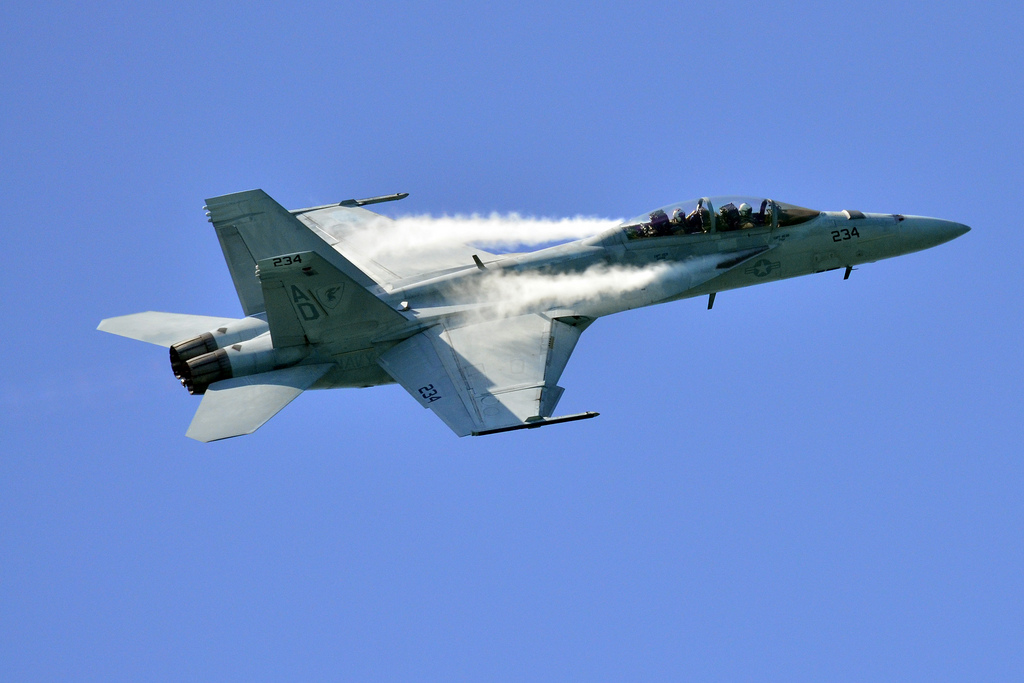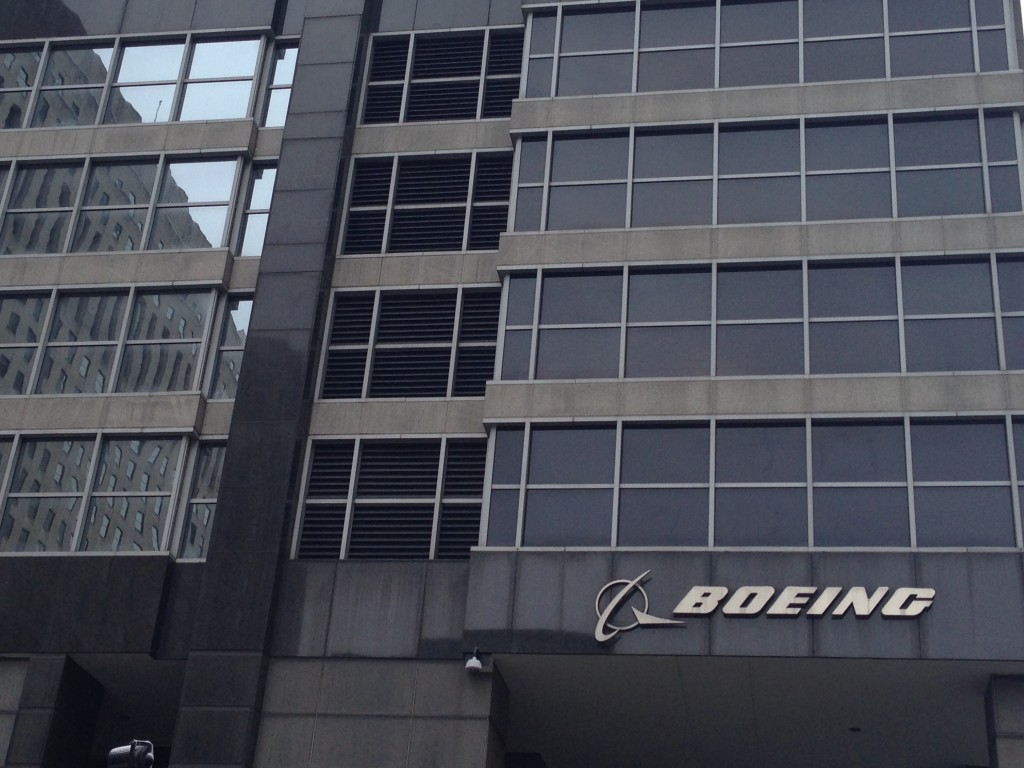
The Obama administration’s latest budget did not include funds to build more of Boeing’s F/A-18E Super Hornet.
Courtesy of Freddy Love.
When the Obama Administration sent its latest budget to Congress earlier this month, the Department of Defense—for the first time in four decades—made no request for funds to build more of Boeing Co.’s F/A-18E Super Hornets and EA-18G Growlers.
Although Boeing had been hoping for more orders of the workhorse military jets used on the U.S. Navy’s aircraft carriers, the absence wasn’t a major surprise: the Pentagon has committed to a new F-35 jet made by Lockheed Martin Corp., and the Navy, which is considering a plan to trim its fleet of carriers from 11 to 10, says it has all the Hornets it needs.
Last year’s sequestration ordered cutbacks in defense spending, meaning fewer deals for defense contractors. For Boeing Defense, Space and Security, one of the nation’s largest defense contractors, one impact of the latest budget cuts could be that the highly profitable Hornet production line in St. Louis, Mo., will close in 2016.
The Hornet cutbacks are only one of a number of challenges that Boeing’s defense group faces as aircraft demand decreases.
The Chicago-based aerospace giant manufactures air, land, sea and space-based products for militaries and governments around the world, though 70 percent of its sales are domestic, with its two biggest customers being the Pentagon and NASA. Profit margins are healthy: Boeing’s defense business represented 38 percent of the company’s total revenues last year, and 49 percent of the parent’s total operating profit.
Despite ongoing defense budget concerns and increasingly tough global commercial-jet competition, Boeing reported increased operating profit and revenue across the company in both its commercial and defense sectors.
Last year Boeing Defense had an operating profit of $3.24 billion, up 5 percent from $3.07 billion in 2012. Sales rose to $33.2 billion, up 2 percent from $32.61 billion in 2012. Helping to fuel the company’s success was increased deliveries of the P-8 maritime aircraft and the Inmarsat-5 satellite.
For Boeing Military Aircraft, the defense unit’s largest source of revenue, operating profit declined 1 percent to $15.94 billion in 2013 from $16.02 billion in 2012, on sales that declined 2 percent to $1.47 million from $1.49 billion.
The Pentagon managed to avoid $20 billion in budget cuts after the $1.1 trillion government-wide spending bill, passed in January, reduced cuts slated to take place this year. Still, even after dodging that bullet, the defense budget remains tight since the 8 percent cut it endured last year.
The bill, known as the Ryan-Murray deal, delayed the full impact of sequestration by about half, Boeing CEO W. James McNerney, Jr. explained in a January conference call.
Although the 2014 defense budget will continue to fund several Boeing programs, including production of aircraft, rotorcrafts and satellites for use by the U.S. military and NASA, the company offered a flat outlook for 2014.
Boeing’s revenue is expected to drop from last year’s figure of $33.2 billion to between $30 and $31 billion in 2014 as defense budget cuts mean less aircraft deliveries, notably of the CH-47 Chinook and V-22 Osprey rotorcraft used by the U.S. Army and U.S. Marine Corps.
“We remain very concerned about longer-term budget uncertainty, the ultimate consequences of sequestration on national security and the potential devastating impact to the nation’s industrial base,” McNerney told analysts.
The turbulence Boeing’s domestic defense operation faces is partially offset by its growing international defense business, which accounted for 26.4 percent of the company’s defense revenues last year. This was a 4 percentage point jump from 22.5 percent in 2007. The company plans to bring in 30 percent of defense revenues from international customers in its first quarter, McNerney said.
Lockheed Martin Corp. remains Boeing’s biggest competitor. The Bethesda, Md.-based company is the Pentagon’s largest defense contractor, supplying much of the aircraft, ground vehicles and missile defense systems used by the U.S. military. In the latest example of the two rivals head-to-head competition, Boeing and Lockheed Martin are now fighting to win what are expected to be sizeable drone contracts from the Pentagon.
To maintain a competitive edge in the current environment, Boeing’s defense group is investing more in innovation, with a focus on unmanned systems development. Last year, the defense operation spent $1.2 billion on research and development, 40 percent of Boeing’s total research spending. That’s a jump from 2009 when Boeing’s commercial aircraft group was developing the high-tech 787 “Dreamliner,” which is now in service; in that year, defense R&D represented 17 percent of the parent’s total.
The products covered by the group’s innovation effort are starting to come off the drawing board. Boeing’s first prototype of an unmanned airborne vehicle, or drone, is the liquid hydrogen fuel-powered Phantom Eye, designed to be an “eye in the sky” to perform reconnaissance and gather intelligence, said Garrett Kasper of Boeing’s Advanced Military Aircraft sector.
The goal is for the drone, already capable of gathering and transmitting information, to be able to travel for seven to 10 consecutive days, Kasper said. Boeing Defense is actively working to lengthen the drone’s wingspan and reduce its “cost-per-flight hour,” a figure comparable to miles-per-gallon heavily considered by Congress when making defense-spending decisions.
Boeing has also developed an unmanned helicopter coined the Unmanned Little Bird. Users program a route on the computer and upload it to the aircraft. It can also be flown by a pilot in situations when human judgment is needed, whether a change in course or if the system fails.
Boeing has also added the ability to control unmanned aircraft to its Apache Guardian combat helicopter. The company is also converting retired F-16 aircraft into drones for surveillance use by the U.S. Air Force.
Apart from aircraft, Boeing is also developing a rugged combat vehicle called the Phantom Badger. At 60 inches wide, it is small enough to fit in the back of Boeing’s V-22 Osprey helicopter. Like a “true innovation vehicle,” its back end can be swapped out “like Legos” with other modules depending on the mission’s needs, Kasper said.
Boeing will continue to face the challenge of keeping its costs down, since the Pentagon heavily considers product affordability when making contract decisions.
“We continue to target organic growth through investments in technology and innovation in areas such as…space unmanned systems, intelligence surveillance and reconnaissance, [and] cybersecurity,” said McNerney.

The Chicago-based aerospace giant manufactures defense products for militaries and governments around the world.





